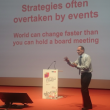

Hype: typically it’s a negative thing. But for those tired of hearing about the next big technology, keep reading. Why? Because the Internet of Things (IoT) is changing the ways of the retail and manufacturing industries, writes David Stain, the industry marketing lead for manufacturing and field mobility at Zebra Technologies in the first of a two part article. (more…)
May 20, 2016
Posted by: George Malim

As IoT becomes increasingly pervasive, a new and alternative services sector is evolving, called servitization – also known as outcome-based services, writes Joe Kenny, the senior director for Global Customer Transformation at field service management specialist, ServiceMax.
By integrating services with products, you can create bundles that are of greater value than products alone. As manufacturers move from being purely product providers to becoming service providers as well, it adds value to their products and generates additional revenue. In other words, service-based outcomes take you out of competing on price alone.
According to Ashton Business School, servitization delivers a 5-10% jump in annual services revenue, profits two to three times greater than those on product sales alone, cost reductions for customers as high as 30%, as well as the opportunity to increase service revenues even further by supporting existing third party or competitive products. This creates an ongoing relationship with the customer that effectively locks out competitors.
Machines are already able to self-diagnose themselves, and report back when they need servicing or require action to be taken to avoid breaking down. This is a game changer for any company with a service department, as well as the wider field service management industry. But shifting business models requires thought and planning. So let’s look at some of the key considerations on the business transformation journey to servitization.
First, validate your business model. Chances are you’ll be making potentially more money but in different ways which will require a rethink. Machines, products and consumers are now all able to communicate with each other in real time, which opens up a myriad of possibilities for monetising revenue in different ways.
Think through the customer experience, and look to add value or provide value in the ecosystem either upstream, downstream or both. By building a better customer experience that’s of value or creating more viability of an asset’s use, you’ll not only be able to unlock new value for your customer, but also potentially profit from it. Be careful not to create vulnerabilities or unnecessary technical baggage to a customer transaction or service. Opt for simple logical value. In my view, simple, reliable and consistent wins over cool every time so don’t over complicate things.
Second, look at security around how the data is collected, protected using encryption, stored and communicated. A good reference is The IoT Security Foundation, which is vendor neutral, non-profit and full of expert resources for knowledge sharing, best practice and advice.
Third, take a look at who owns the data captured and the consolidated trends. We now have laws that cover control data captured, data protection, ownership and the protection of personal information. Talk to your legal department and review these aspects, and include them in your end user agreements – clearly state what data is collected and how relates to protection and usage rules.
Fourth, ensure you understand the technology you are using. Have you designed for quality of reporting, and for failure, scalability, reliability? How will you know the sensors are reporting back with valid measurements? It’s really important to test, test and test again – everything from sensor locations, fixings, power supply, communication methods and circuit redundancy.
Fifth, check Industry 4.0 for ideas. In other words, check for standards and emerging templates or blueprints. You can be creative but it’s worth doing your research to get plenty of advice. Always build trial or proof of concept on small scale then methodically learn what business outcomes you can drive or improve – but keep a holistic focus on improving value. And consider how are you going to install, maintain, upgrade, retrofit, or decommission your solution, and once deployed, make sure you recalibrate your expectations on a continual basis.
There are a few obstacles to overcome, but the reality is we have been monitoring sensors in machines for years. As an industry, we already know what good, reliable data looks like and most companies are familiar with the thresholds of proper testing and validation.
The convergence of IoT and servitization is transforming business models in the service arena, opening new possibilities for proactive maintenance, prescriptive management and recall management. Your only decision is how to transform your business to take advantage of them.
May 19, 2016
Posted by: George Malim

The massive proliferation of threats and the shifting nature of risk were highlighted at the recent WeDo Technologies Worldwide User Group Summit 2016 in Lisbon, Portugal. Among the presentations and discussions at the event, Dr Patrick Dixon, a futurist and founder of Global Change Ltd., examined how threats will alter and why traditional approaches won’t work. George Malim reports from Lisbon. (more…)
May 18, 2016
Posted by: George Malim

Johannes Petrowisch, a partner account manager at industrial automation software expert COPA-DATA, continues his discussion of the role of data collection and analysis in the smart cities of tomorrow in the second part of his blog. (more…)
May 16, 2016
Posted by: George Malim

The largest ant colonies in the world contain over 300 million individuals and cover areas that are several kilometres wide. Ants mostly rely on tactile and chemical means of communication to keep these huge systems in order. Luckily, as humans, we have additional tools at our disposal to make our homes and cities more efficient, more organised and, to put it simply, better places to live in. (more…)
May 13, 2016
Posted by: George Malim

Given the explosion of data generation in the life sciences, and the extension of the industry’s end-to-end supply chains it is crucial that we employ solutions for global and social collaboration, writes Stephen Chadwick, the managing director for EuroNorth at Dassault Systèmes. (more…)
May 12, 2016
Posted by: George Malim

The difficulty when creating something new is that there is no template to follow, writes Narayan Menon, the CTO of XCellAir. No flat pack manual that takes you through the trickier parts step by step. (more…)
May 10, 2016
Posted by: George Malim

According to reports published by ARUP the global Smart Cities Market is expected to grow to $1,134.84 billion by 2019. While this looks promising for all involved, writes David Rolfe, the Big Data Platform product manager at Openet, the challenges in supporting a connected city are a lot more complex than simply implementing the latest technology. (more…)
May 9, 2016
Posted by: George Malim

Adrian Crawley, the regional director of Northern EMEA for Radware, continues his blog on the challenges facing utilities providers as they embrace and integrate with IoT. (more…)
May 6, 2016
Posted by: George Malim

In the second part of his blog, Dennis Poulsen, the general manager of Spirent’s IoT Connectivity Products, concludes his exploration of the IoT options for the OEM. The most immediate solution would be to buy SIM card reader components and build them into the product, which can then be sold as “Internet enabled”. The customer then buys the device, chooses a suitable mobile service provider and a suitable connection package, inserts the SIM card and configures and customizes the product themselves. (more…)
May 5, 2016
Posted by: George Malim